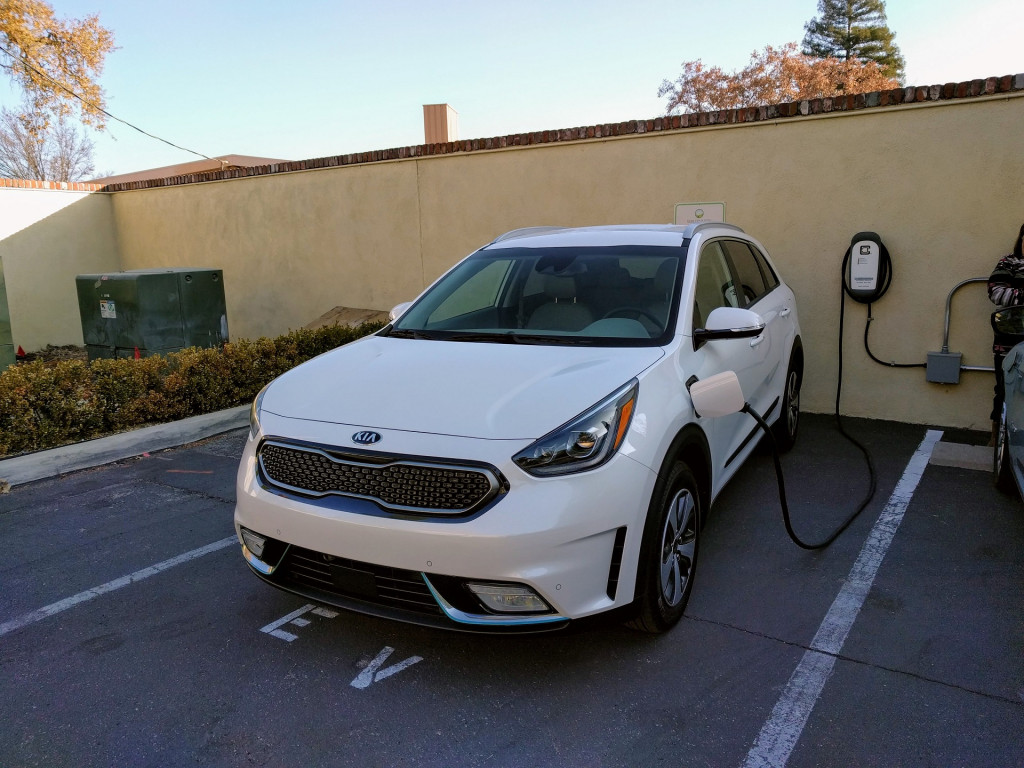Most highly fuel-efficient dedicated hybrids are compact five-door hatchbacks, the most popular vehicle segment globally.
When Korean maker Kia was drawing up plans for its first dedicated hybrid vehicle, it took a different path.
The wagon it came up with—it calls the Kia Niro a crossover, we disagree—has been a success in the U.S., selling at rates more than twice those of the Hyundai Ioniq that shares the same underpinnings.
DON'T MISS: 2018 Kia Niro Review
In its second year, the 2018 Kia Niro adds an alternative to the sole conventional hybrid powertrain offered in 2017.
In addition to the Niro Hybrid—EPA-rated at 50, 49, or 43 mpg combined depending on model—there's a new 2018 Kia Niro Plug-In Hybrid.
That vehicle is rated at 26 miles of all-electric range, 105 MPGe when running electrically, and 46 mpg combined as a conventional hybrid after the battery is depleted.

2017 Kia Niro, San Antonio, Texas, Dec 2016
We tested the plug-in hybrid Niro in December and found it to be what we expected: a Niro Hybrid with more battery and electric-running capabilities.
Overall, the 26-mile range was borne out in a variety of uses, though we should note our test route in coastal California had mostly temperate weather, with overnight lows dipping only into the 40s F.
Both 2018 Kia Niro versions have roughly equivalent cargo space, and we're fans of the handsome wagon shape.
READ THIS: 2018 Kia Niro Plug-In Hybrid first drive review
We'd suggest shoppers not be fooled by any marketing they might see: The Niro is not a crossover utility vehicle, no matter what Kia calls it.
You can't get all-wheel drive—a key qualification for anything to be called a "utility vehicle" in our eyes.
Kia Motors USA executives have said it's a perennial request from their product planners to the South Korean engineers.

2018 Kia Niro Plug-In Hybrid charging at Paso Robles Inn, Paso Robles, California, Dec 2017
Kia points out the rated total range of the plug-in hybrid Niro is 560 miles.
With only a single full recharge of the battery overnight at our hotel, plus many short fractional recharges, we didn't buy gas at all during 500 miles of high-speed and sometimes aggressive driving.
In our December 2016 road test of the conventional Niro Hybrid, the only one on offer for the 2017 model year, we covered three test-drive legs around a surprisingly chilly San Antonio—all using a mix of Eco and Sport modes.
CHECK OUT: 2017 Kia Niro hybrid: first drive report
Our fuel-economy figures on the trip computer came in at 34.7 mpg, 41.7 mpg, and 45.7 mpg in the Niro Hybrid version carrying a 43-mpg combined rating.
To be fair, while the first of those is much lower than an acceptable 10 to 12 percent variance from the EPA rating, it included climbing into the mountains around the city.
The third number was descending back down those same mountains, and correspondingly higher than that same combined rating.

Kia Niro EV concept
Both versions are powered by a 103-horsepower 1.6-liter 4-cylinder engine and 6-speed dual-clutch automatic-shifting gearbox that sandwich the electric motor.
The Niro plug-in has a more powerful electric motor, however: It's rated at 45 kilowatts (60 hp), rather than the 32-kw (43-hp) motor used in the regular Niro Hybrid.
But there's another Niro version coming, whether for the 2019 or 2020 model year: an all-electric Niro EV that will either complement or supplant today's Kia Soul EV, the tall wagon that got a slight battery-capacity boost to raise its rated range to 111 miles.
COMING SOON: Kia Niro EV concept at CES: 238 miles of range from 64-kwh battery
The all-electric Niro will differ from its sibling-under-the-skin, this year's Hyundai Ioniq Electric, by offering a much larger 64-kwh battery and, Kia claims, a rated range of 238 miles—precisely the number offered by the Chevrolet Bolt EV electric car.
Kia showed a prototype Niro EV Concept at the Consumer Electronics Show in Las Vegas earlier in January, though it said little about its "next-generation electric powertrain," beyond saying it used "new production technologies earmarked for near-future EVs from Kia."
It did note that the larger battery was "paired with a powerful 150-kilowatt [200-horsepower] electric motor."













